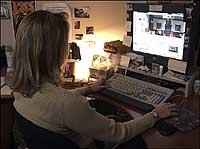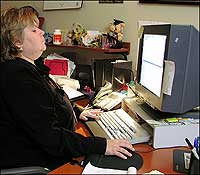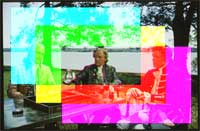Page content
Remastering a Masterwork
Restoration of The Patriot
by Richard L. McCluney Jr.
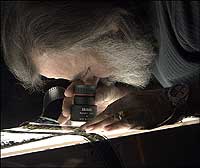
"Basically, anything that could have been wrong with the film was wrong with it," Jerry Pooler said. He helped develop software at CineSite that allowed combining elements from different pieces of the original.
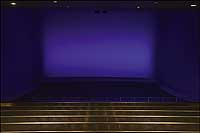
The Patriot Theaters in Colonial Williamsburg's Visitor Center were built to show one film and one film only: Williamsburg—The Story of a Patriot.
And they have been showing it continuously since 1957. Filmed in wide-screen VistaVision, with six-track stereo sound, the movie has introduced Colonial Williamsburg to more than thirty million theater viewers.
He bragged about the film all the way from Washington, D.C., to Colonial Williamsburg. He told his son that the color and clarity of the VistaVision movie would open a window on the past. A skeptical thirteen-year-old, the youngster would see for himself. They sat in a darkened Visitor Center theater, and sounds filled the room. Williamsburg—The Story of a Patriot began. A minute or two later the son gave his father a look that fathers of teenagers know well. A look that says, "Oh, Dad. Please."
The color, the sharpness, and clarity that had made such an impression when his father saw the film in 1958, a year after it premiered, were gone. Dad was disappointed. Worse, he had disappointed his son. The movie showed its age, nearly forty at the time. The colors had faded; the film was grainy and, well, fuzzy. The Patriot, as the motion picture is commonly called, was a shadow of its former greatness.
The longest-running motion picture ever, for forty-seven years The Patriot has introduced guests to Williamsburg and America on the eve of the Revolution. It shows the people of eighteenth-century Williamsburg as they might have been, introduces characters that made the nation, helps audiences understand the issues that divided colonists from one other and from the mother country. It looks down a vista of the past. A vista made possible by John D. Rockefeller Jr.'s restoration of the town, and Hollywood and history's best collaboration. By the 1990s, The Patriot had to be restored or abandoned. It was that serious.
The father was not a person to simply say to his son, "Well, you should have seen it before." He was Robert A. Harris, president of the Film Preserve, a New York company that had a hand in restoring Lawrence of Arabia, Spartacus, and My Fair Lady. He went looking for whoever was responsible for The Patriot, and that brought him to me. Harris and I talked for hours.
It was 1995.
The Patriot is an elite motion picture production. The director, writers, cast, and crew were among Hollywood's best multiple Academy Award winners, under the direction of George Seaton. For sets they had the $60 million-plus resuscitation of Williamsburg and two well-preserved historic Virginia plantations. The filmmakers took as much pride in the work as they did in the most important theatrical releases. Maybe more.
When it premiered in March of 1957, The Patriot was one of the most technologically advanced films, one of a few motion pictures, and the only nontheatrical film, photographed in VistaVision, an ultrawide screen, big movie format. It was shot to be screened in twin theaters—the Patriot Theaters—designed for it and for no other movie.
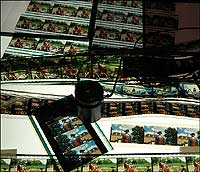
The VistaVision frames of The Patriot contain three times the information of a regular 35 mm image. Each of the film's 52,000 frames had to be worked on to produce the final restoration.
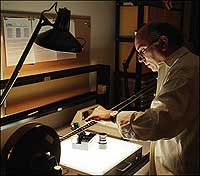
Robert Harris of the Film Preserve in New York found Eastman Kodak's CineSite in Hollywood to do the job.
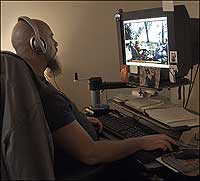
Monty Phillips, lead artist, above, and Valerie McMahon, compositor, below, worked on The Patriot at CineSite's offices.
By 1990, The Patriot had run afoul of a problem that was threatening many color films made from 1955 to 1960. It had been made on an Eastman Kodak color negative film that recorded the spectrum of tints, hues, and shades by exposing three layers in the stock. One was magenta, a kind of red; the second, cyan, a kind of blue-green; and the third was yellow. Together these layers produced the magnificent colors that The Patriot shared with the blockbusters of its day.
The colors had faded, especially the yellow die. Nearly all of the information stored in that layer was lost. Harris: "Because of the yellow fading, blacks go blue, highlights go dull blue, faces go crustacean, which is wonderful if you're a lobster. The film loses contrast and contrast controls sharpness.
"Overall the image was ugly, and not acceptable."
For the most important films, separation masters—three black and white prints—were made. Each includes the information from a single color layer of the original. Normally, if the original negative was damaged or faded, one could turn to them. Under ideal circumstances a new negative using the information from all three separation masters would closely approximate the original. Fortunately, the Colonial Williamsburg Foundation had produced separation masters for The Patriot. Unfortunately, the clear plastic base material for these masters had begun to shrink. And they didn't shrink evenly. That meant the three color images didn't register, or line up. Prints made from them would be distorted. The color would be questionable, with increased grain and decreased sharpness.
Also not acceptable. This was what Harris and his son and all of Colonial Williamsburg's guests were seeing by 1995.
In 1995, an attempt was made to create a new negative using conventional film restoration technology. The old shrunken, brittle film elements were used to make just one duplicate negative. The demise of The Patriot had been postponed.
But only postponed.
The film elements used to create the internegative had been damaged beyond repair. New copies of The Patriot would have to come from another source.
Enter the digital age.
Since computers had become an integral part of filmmaking, I hoped that the salvation and restoration of The Patriot might be accomplished electronically. In 1995 the technology wasn't available. By 2001 it was. It seemed that it might be possible to restore The Patriot for the next generation of Williamsburg visitors.
The Colonial Williamsburg Foundation began raising the funds the project required. Major support was provided by Royce R. and Kathryn M. Baker; Marcia and John R. Donnell Jr.; the Joullian Foundation, Inc.; Letitia and Edward C. Joullian; Ruth H. and James H. Keene III; Gretchen B. and William R. Kimball; Virginialee and Edward Lynch; Abby and George O'Neill; Lois and Dick Vieser; and Bob and Marion Wilson.
Other contributors included Dr. William A. and Patricia L. Chantry; Kenneth R. Hunt; myself; Laura C. Miller; Charlotte M. Morehouse; Judy E. Morse; Brigit and David S. Wilson; Kenneth M. and Sally P. Wolfe; and Louise G. and Gordon S. Wood.
Harris was engaged to supervise the restoration and began searching for the people who could do the work.
He found them at CineSite, a Kodak company with offices in Hollywood and London which had just worked on the digital restoration of parts of Disney's Snow White and Fantasia. Restoring The Patriot would prove more demanding. Digital film restoration is an emerging craft that combines the power of massive computers with the skill of artists. At best the work is painstaking. Each color layer of each film frame must be scanned into the computer at the highest resolution possible, cleaned, and color corrected by eye. All the frames must match each other so the film doesn't look like a patchwork of colors when it's reassembled. It's a difficult, time-consuming task when the original film is in good condition. The Patriot was in not in good condition. It would take an extraordinary effort to restore.
Normally, the digital scans are made from the original camera negative. They tried, but according to Jerry Pooler of CineSite, the results were unacceptable. Yellow die failure. Pooler: "The original negative, the yellow layer, had collapsed, had actually become black. There was a little bit of information in there, but when you combined it with the red and green channels, it produced a yellow-looking piece of film which is not acceptable."
The separations would not produce an acceptable image either.
Harris: "The film preservation elements, the separation master, holds one third of the spectrum of light on separate black and white prints. Those had been damaged. They had shrunken, they had what was called differential shrinkage, and those would no longer fit together. So basically anything that could have been wrong with the film was wrong with it."
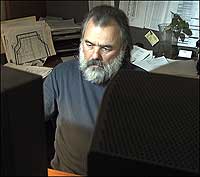
Jerry Pooler helped develop software at CineSite that allowed combining elements from different pieces of the original. The Patriot was made by some of Hollywood's best professionals in the 1950s. In the twenty-first century, it returned to Hollywood for its restoration.
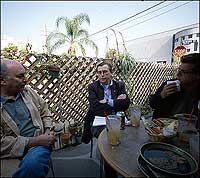
Audio consultant Michael Frondelli, right, Richard McCluney of Colonial Williamsburg, and Robert Harris meet.
Harris and the CineSite wizards devised a plan. They would take the digital data from each of the elements and merge that data into a coherent and pleasing version of the film. Harris: "The challenge was to find a way to put these disparate elements together and coming close to what the film looked like in 1957."
It meant a tremendous amount of work ...and a gigantic data storage system. Harris and CineSite scanned The Patriot's original negative for the computer. Then they scanned the best material from the three separations. Frame by frame. There are more than 52,000 frames in the film. Huge frames. Remember The Patriot was made in VistaVision, a format in which there is about three times the data per frame as on a standard motion picture frame. Each frame translates to more than 100 megabytes of data. There are twenty-four frames to a second. If you're burning CDs at home you can get six frames on one. A quarter of a second. To store all of the elements needed to restore The Patriot takes about 21,000 CDs. And that was just for backup.
Online storage required more. More than half of CineSite's capacity. Enough to fill up every computer on your street, your neighborhood, maybe your town. Andrew Bonello, image-processing developer at CineSite: "It was a huge resource management project. To give you an idea, we've scanned about 142,000 frames of film onto our data service here and that takes up about fourteen terabytes of data, which is roughly equivalent to about seven features according to our normal pipeline. So the data requirements for this film, even though it is shorter than a feature film, have been pretty high."
Now the real film restoration work began. Every frame was examined on a computer, and cleaned of dust and dirt. Scratches were removed and the colors corrected with sophisticated paint programs. CineSite artists spent months with a few feet of film. They lived with John Fry, the central figure of The Patriot, and his family, with the heroes of the American Revolution, and with Williamsburg. They worked on images alone. Not the soundtracks. They developed a passion for The Patriot without ever really experiencing it.
They did an enormous amount of testing to determine the best combinations of elements they would use to reconstruct each scene. Meanwhile, they created software tools that would help them recombine the data from the frames.
One of the tools was critical. Pooler: "It gives us the freedom to use different elements at will. If we find that there's a cyan layer in one negative and a magenta layer in another negative, there's scratches in one layer. We can go to a negative that doesn't have the scratches in it and pull that layer up. We can recombine with separations ...we can come up with a good-looking end product that was never before possible."
CineSite created other tools, including software that lets the computers register the separation elements automatically. Pooler: "When you get two pieces of film that were created at different times, on different cameras, with different movements, stored differently, you get different shrinkage rates. Photochemically you can blindly put them back together again, and they may or may not line up. Registration is a major problem. We can take two, three, or four different elements, put them back together again, and put them into exact registration automatically.... We can mix and match, if you will, the elements that we want to use, to get the best-looking output. The best-looking color."
The motion picture industry will benefit from The Patriot project. The tools and techniques developed will save other great films.
Brad Reinke, CineSite restoration manager: "Every time we do a project there's always new tools created that we implement and move forward on new projects. Williamsburg is wonderful in that we have actually built three to four new tools that we hope to use on future projects."
Harris: "What we've accomplished with CineSite means the industry and film restoration" have "the ability to work with disparate records, disparate elements, and different layers of film, put them together in different ways, control them in different ways, control the grain, control the contrast, make things fit together that basically were never meant to fit together. And come out the other side with a element that's quite representative of what the film looked like almost fifty years before."
The restored Williamsburg—The Story of a Patriot is not an exact duplicate of the original. The original was too far gone for that. It is the best approximation possible. It will look as much like the original as I and Harris, and the people at CineSite and Eastman Kodak, and many more can make it.
The Patriot has played to more than thirty million guests in the Patriot Theaters. With the new negatives it can play to thirty million more after it premiers later in 2004 at the revitalized Patriot Theaters. For home viewing, we're producing an enhanced DVD version of the film.
Harris: "The film is important for many reasons. Number one, it's the longest running film in motion picture history, constantly running since 1957. Number two, it's the only film that was ever shot in VistaVision eight perforation, horizontal, real VistaVision to be run large format, with six tracks of stereo sound. And it's an artifact of the period of the fifties which tried to explain what Williamsburg was all about to the audience. And it worked. It just worked as a film."
Colonial Williamsburg is all about historic preservation, restoration, and education. Its iconic buildings stand as testament to the institution's success and expertise. Colonial Williamsburg pioneered historical interpretations and innovations in personalizing history. And Colonial Williamsburg was the first outdoor historical museum to employ the power of sound and the moving picture to tell its story.
Williamsburg—The Story of a Patriot is a symbol of dramatic history telling, and a milestone in the history of motion pictures. Forty-seven years after it was produced it has helped set new standards for film restoration. Now and forever, audiences will be able to revel in the color and sounds of eighteenth-century Williamsburg. The next time Harris brings his son to watch The Patriot he will see what his father saw that first time in 1958:
"An image that was like looking through an open window to the past. It was just so visually stunning and brilliant that it left an impact on me forever."
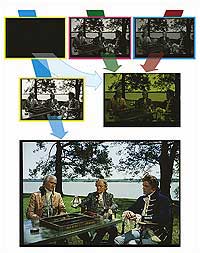
How The Patriot Was Restored:
Three color layers in film—cyan, magenta, and yellow—act as
filters to control red, blue, and green light and combine to produce the full-color image on the screen.
In the old negative, the yellow layer had faded, leaving almost no blue information. The magenta layer controls green information, and the cyan layer controls red information. With new digital technology and computer enhancement of the
old color separation, Kodak's Cinesite created a new yellow layer. Before restoration, the old frames from the film had unacceptable color, contrast, and resolution. A nearly perfect restoration of The Patriot was
the result of digital restoration of the three color layers and removal of scratches, dust, and dirt.
 Succinct Script Yields Memorable Quotes
Succinct Script Yields Memorable Quotes
Read a sidebar about a dilemma with the script and view video clips of favorite lines from the film.
See how the color layers of the film interact with each other in this Flash movie. Click image to play
Richard L. McCluney Jr. is Colonial Williamsburg's Royce R. and Kathryn M. Baker vice president for productions, publications, and learning ventures.

"Williamsburg, The Story of a Patriot" DVD $24.95
Now available in Colonial Williamsburg retail stores and online through www.williamsburgmarketplace.com
For further reading:

